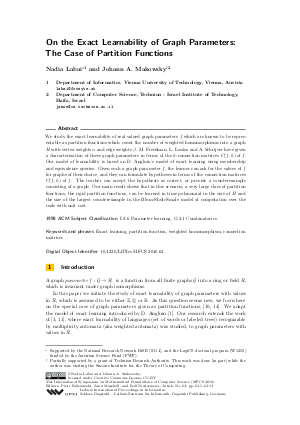On the Exact Learnability of Graph Parameters: The Case of Partition Functions
Authors Nadia Labai, Johann A. Makowsky
-
Part of:
Volume:
41st International Symposium on Mathematical Foundations of Computer Science (MFCS 2016)
Part of: Series: Leibniz International Proceedings in Informatics (LIPIcs)
Part of: Conference: Mathematical Foundations of Computer Science (MFCS) - License:
 Creative Commons Attribution 3.0 Unported license
Creative Commons Attribution 3.0 Unported license
- Publication Date: 2016-08-19
File

PDF
LIPIcs.MFCS.2016.63.pdf
- Filesize: 0.56 MB
- 13 pages
Document Identifiers
Subject Classification
Keywords
- exact learning
- partition function
- weighted homomorphism
- connection matrices
Metrics
- Access Statistics
-
Total Accesses (updated on a weekly basis)
0PDF Downloads0Metadata Views
Abstract
We study the exact learnability of real valued graph parameters f which are known to be representable as partition functions which count the number of weighted homomorphisms into a graph H with vertex weights alpha and edge weights beta. M. Freedman, L. Lovasz and A. Schrijver have given a characterization of these graph parameters in terms of the k-connection matrices C(f,k) of f. Our model of learnability is based on D. Angluin's model of exact learning using membership and equivalence queries. Given such a graph parameter f, the learner can ask for the values of f for graphs of their choice, and they can formulate hypotheses in terms of the connection matrices C(f,k) of f. The teacher can accept the hypothesis as correct, or provide a counterexample consisting of a graph. Our main result shows that in this scenario, a very large class of partition functions, the rigid partition functions, can be learned in time polynomial in the size of H and the size of the largest counterexample in the Blum-Shub-Smale model of computation over the reals with unit cost.
Cite As Get BibTex
Nadia Labai and Johann A. Makowsky. On the Exact Learnability of Graph Parameters: The Case of Partition Functions. In 41st International Symposium on Mathematical Foundations of Computer Science (MFCS 2016). Leibniz International Proceedings in Informatics (LIPIcs), Volume 58, pp. 63:1-63:13, Schloss Dagstuhl – Leibniz-Zentrum für Informatik (2016)
https://doi.org/10.4230/LIPIcs.MFCS.2016.63
BibTex
@InProceedings{labai_et_al:LIPIcs.MFCS.2016.63,
author = {Labai, Nadia and Makowsky, Johann A.},
title = {{On the Exact Learnability of Graph Parameters: The Case of Partition Functions}},
booktitle = {41st International Symposium on Mathematical Foundations of Computer Science (MFCS 2016)},
pages = {63:1--63:13},
series = {Leibniz International Proceedings in Informatics (LIPIcs)},
ISBN = {978-3-95977-016-3},
ISSN = {1868-8969},
year = {2016},
volume = {58},
editor = {Faliszewski, Piotr and Muscholl, Anca and Niedermeier, Rolf},
publisher = {Schloss Dagstuhl -- Leibniz-Zentrum f{\"u}r Informatik},
address = {Dagstuhl, Germany},
URL = {https://drops.dagstuhl.de/entities/document/10.4230/LIPIcs.MFCS.2016.63},
URN = {urn:nbn:de:0030-drops-64750},
doi = {10.4230/LIPIcs.MFCS.2016.63},
annote = {Keywords: exact learning, partition function, weighted homomorphism, connection matrices}
}
Author Details
References
-
D. Angluin. On the complexity of minimum inference of regular sets. Information and Control, 39(3):337-350, 1978.

-
D. Angluin. Queries and concept learning. Machine Learning, 2(4):319-342, 1987.

-
A. Beimel, F. Bergadano, N. H. Bshouty, E. Kushilevitz, and S. Varricchio. Learning functions represented as multiplicity automata. Journal of the ACM (JACM), 47(3):506-530, 2000.

-
G. D. Birkhoff. A determinant formula for the number of ways of coloring a map. Annals of Mathematics, 14:42-46, 1912.

-
L. Blum, F. Cucker, M. Shub, and S. Smale. Complexity and real computation. Springer Science &Business Media, 2012.

-
L. Blum, M. Shub, S. Smale, et al. On a theory of computation and complexity over the real numbers: NP-completeness, recursive functions and universal machines. Bulletin (New Series) of the American Mathematical Society, 21(1):1-46, 1989.

-
B. Bollobás. Modern Graph Theory. Springer, 1999.

-
J. Draisma, D. C. Gijswijt, L. Lovász, G. Regts, and A. Schrijver. Characterizing partition functions of the vertex model. Journal of Algebra, 350(1):197-206, 2012.

-
P. Erdős and A. Rényi. Asymmetric graphs. Acta Mathematica Hungarica, 14(3-4):295-315, 1963.

-
M. Freedman, L. Lovász, and A. Schrijver. Reflection positivity, rank connectivity, and homomorphism of graphs. Journal of the American Mathematical Society, 20(1):37-51, 2007.

-
A. Habrard and J. Oncina. Learning multiplicity tree automata. In Grammatical Inference: Algorithms and Applications, pages 268-280. Springer, 2006.

-
J. Kötters. Almost all graphs are rigid—revisited. Discrete Mathematics, 309(17):5420-5424, 2009.

- N. Labai and J. A. Makowsky. On the exact learnability of graph parameters: The case of partition functions. arXiv preprint arXiv:1606.04056, 2016. URL: http://arxiv.org/abs/1606.04056.
-
L. Lovász. Large Networks and Graph Limits, volume 60 of Colloquium Publications. AMS, 2012.

-
L. Lovász. The rank of connection matrices and the dimension of graph algebras. European Journal of Combinatorics, 27(6):962-970, 2006.

-
A. Schrijver. Graph invariants in the spin model. J. Comb. Theory, Ser. B, 99(2):502-511, 2009.

-
A. Schrijver. Characterizing partition functions of the spin model by rank growth. Indagationes Mathematicae, 24.4:1018-1023, 2013.

-
A. Schrijver. Characterizing partition functions of the edge-coloring model by rank growth. Journal of Combinatorial Theory, Series A, 136:164-173, 2015.

-
A. D. Sokal. The multivariate Tutte polynomial (alias Potts model) for graphs and matroids. In Survey in Combinatorics, 2005, volume 327 of London Mathematical Society Lecture Notes, pages 173-226, 2005.

